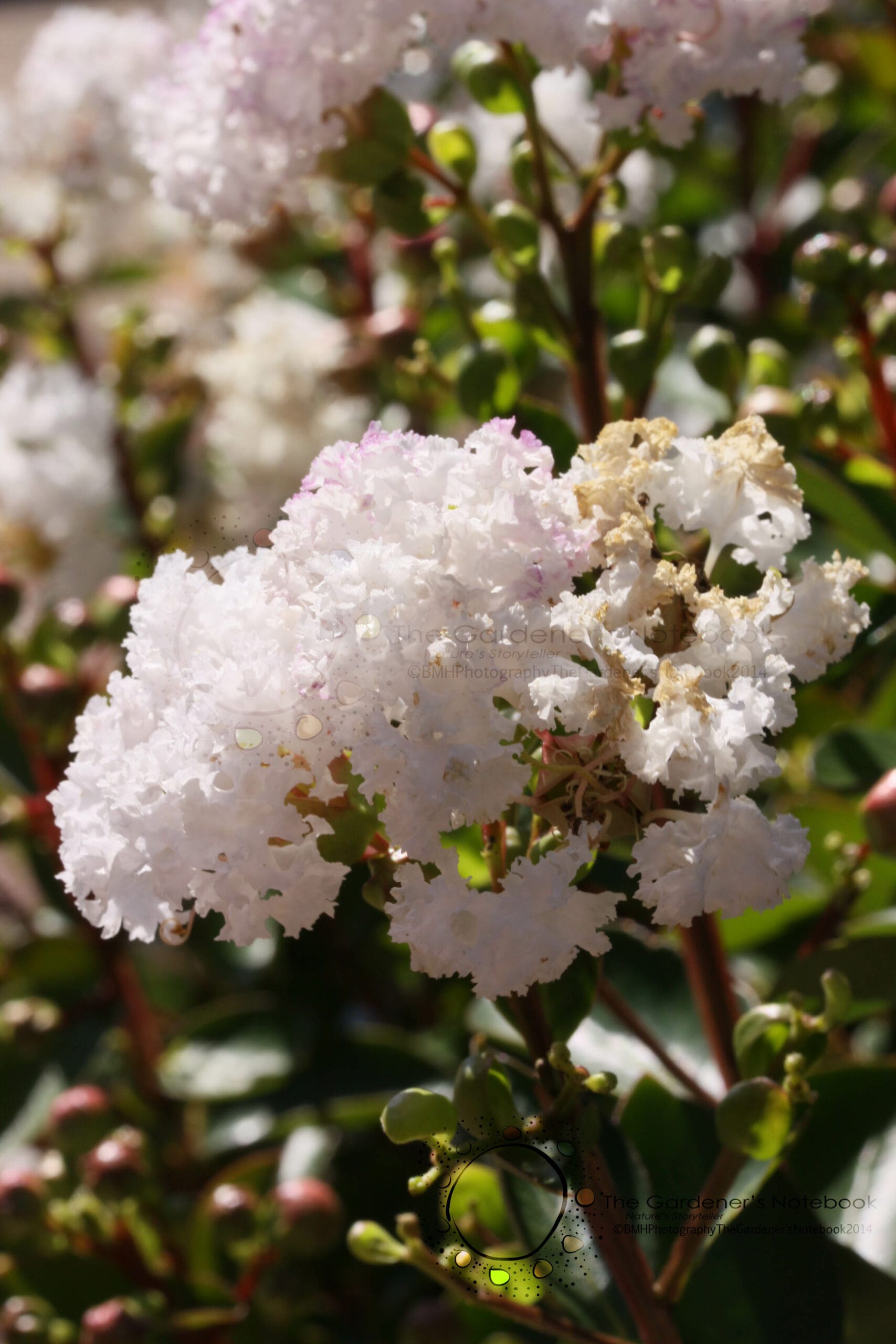Crepe Myrtles: Vibrant blooms, stunning bark, and dazzling fall color – a multi-season landscaping gem. These versatile trees and shrubs bring a touch of Southern charm to gardens across a surprising range of climates. Whether you’re a seasoned gardener or just starting out, this comprehensive guide will equip you with everything you need to know about crepe myrtle varieties, care, and problem-solving. Let’s transform your garden into a year-round spectacle of color!
Unveiling the Beauty of Crepe Myrtles
Crepe myrtles ( Lagerstroemia ), members of the Lythraceae (loosestrife) family, offer captivating beauty throughout the year. With approximately 50 species, including both deciduous and evergreen varieties, these adaptable plants range from petite shrubs to small trees. Their vibrant summer blooms, in a spectrum of colors from pristine white to deep purples, are truly showstopping. But the beauty doesn’t end there! Even after the blooms fade, the attractive, exfoliating bark adds winter interest, while the foliage puts on a fiery display of fall color, ranging from brilliant yellows and oranges to deep reds. Native to the Indian subcontinent, Southeast Asia, Northern Australia, and Oceania, crepe myrtles have naturalized in the Deep South of the US and thrive in USDA Hardiness Zones 6-9. With the right care, you can likely cultivate these beauties in a variety of locations.
Cultivating Crepe Myrtle Success: Essential Care Tips
Nurturing healthy, vibrant crepe myrtles hinges on understanding their basic needs. These sun-loving plants crave at least six hours of direct sunlight daily. Provide them with this golden elixir, and they’ll reward you with abundant blooms and robust growth. Well-drained soil is another crucial factor. Heavy clay soils can lead to root rot, so ensure proper drainage to keep your crepe myrtles happy. Consistent watering is essential, especially for young trees, but avoid overwatering, which can be detrimental. Deep, infrequent watering, allowing the soil to dry slightly between waterings, is the ideal approach. While not heavy feeders, crepe myrtles can benefit from a light application of balanced fertilizer. Avoid over-fertilizing, as this can actually reduce blooming. [https://www.lolaapp.com/state-park-reviews]
Mastering the Art of Crepe Myrtle Pruning
Pruning plays a key role in shaping crepe myrtles and maximizing their blooming potential. Late winter or early spring, before new growth appears, is the prime time to prune. Research various pruning techniques to avoid the dreaded “crepe murder,” a detrimental practice of excessive topping that can harm the plant’s health and aesthetics. Instead, focus on selective pruning to remove dead, crossing, or diseased branches, and to shape the plant for optimal form and flowering.
Selecting the Perfect Crepe Myrtle: A World of Variety
The sheer diversity of crepe myrtle varieties is truly remarkable. They come in a wide array of sizes and forms, from dwarf shrubs perfect for containers to small trees suitable for larger landscapes. Flower colors span the spectrum, from pure white to vibrant pinks, deep reds, and rich purples. Bloom times also vary, allowing you to create a staggered blooming sequence for continuous color throughout the summer months. With so many options, you can find the ideal crepe myrtle to perfectly complement your garden design and personal preferences.
Troubleshooting Crepe Myrtle Challenges: A Problem-Solving Guide
Even with the best care, crepe myrtles can occasionally encounter challenges. Common issues include powdery mildew, a white, dusty coating on the leaves, and pests like aphids and Japanese beetles. Don’t despair! These problems are often manageable. Powdery mildew can be addressed with fungicides or by improving air circulation through proper pruning. Aphids and Japanese beetles can be controlled with insecticidal soap or other targeted treatments. Remember, an ounce of prevention is worth a pound of cure. Proper care, including adequate sunlight, well-drained soil, and appropriate watering, can go a long way in preventing problems.
Crepe Myrtle Pests: Identification and Control
- Aphids: These tiny sap-sucking insects can weaken the plant and cause honeydew, a sticky substance that attracts ants and sooty mold. Treat with insecticidal soap or neem oil.
- Japanese Beetles: These metallic-green beetles can defoliate crepe myrtles. Hand-picking, traps, or insecticides can be used for control.
- Bark Scale: This pest appears as white, cottony masses on the bark and can weaken the plant. Horticultural oil or systemic insecticides can be effective.
Crepe Myrtle Diseases: Diagnosis and Treatment
- Powdery Mildew: This fungal disease causes a white, powdery coating on the leaves. Treat with fungicides or improve air circulation through pruning.
- Cercospora Leaf Spot: This fungal disease causes brown spots on the leaves. Remove affected leaves and treat with a fungicide.
Leveling Up Your Crepe Myrtle Expertise: Advanced Techniques
Once you’ve mastered the basics, delve deeper into the nuances of crepe myrtle care.
Microclimate Considerations
Explore how microclimates within your garden can influence crepe myrtle growth and blooming. Factors like wind exposure, temperature fluctuations, and humidity levels can impact plant performance.
Advanced Pruning Strategies
Discover specialized pruning techniques to achieve specific shapes and sizes. Techniques like thinning cuts and heading cuts can be used to refine the plant’s structure and promote flowering.
Optimizing Soil Conditions
Improve soil drainage and nutrient availability by incorporating organic matter like compost or peat moss. A soil test can help determine any nutrient deficiencies and guide appropriate amendments.
Integrated Pest Management
Embrace integrated pest management strategies to minimize the use of chemical pesticides. This approach combines various methods like natural predators, cultural practices, and targeted treatments for effective pest control.
Crepe Myrtles in Containers: Patio Perfection
Crepe myrtles can thrive in containers, making them ideal for patios, balconies, and smaller spaces. Select compact varieties and use well-draining potting mix. Ensure adequate sunlight and water regularly. Winter protection may be necessary in colder climates.
Crepe Myrtle Fascinating Facts
- Wildlife Attraction: Attract pollinators like butterflies and hummingbirds, adding life and movement to your garden.
- Design Versatility: Can be used as standalone specimens, hedges, borders, or in mass plantings for a dramatic effect.
- Name Origin: The crinkled petals resemble crepe paper, giving rise to the name “crepe” myrtle.
Visit Crater of Diamonds, a remarkable state park, to discover real diamonds, and consult our comprehensive state-park-reviews for planning advice
Crepe Myrtle Cultivation in the UK: A Gardener’s Challenge
Can crepe myrtles flourish in the UK’s cooler climate? While they are warmth-loving plants, success is certainly probable with careful planning and attention. Choosing hardy varieties like Lagerstroemia fauriei is key. These cultivars exhibit greater tolerance to colder temperatures and common fungal diseases. A south-facing, sheltered location that maximizes sunlight exposure is ideal, providing the warmth these plants crave. Winter protection is essential, especially for younger trees or those grown in containers. Potted crepe myrtles may benefit from being brought indoors or into a greenhouse during the coldest months. For in-ground plants, wrapping the base of the trunk with burlap or horticultural fleece provides insulation and protects against frost damage. Mulching around the base of the tree can further insulate the roots. Research suggests that with appropriate care and cultivar selection, crepe myrtles can increasingly become viable garden choices even in regions with shorter growing seasons.
Navigating the Drawbacks of Crepe Myrtles
While crepe myrtles offer many advantages, it’s important to be aware of potential downsides. Their popularity can contribute to monoculture landscapes, reducing biodiversity and ecosystem resilience. They can be susceptible to pests like aphids and bark scale. Fallen flowers, seed pods, and sooty mold can create messiness, requiring regular cleanup. Overuse can also lead to visual uniformity in landscapes. By understanding these potential drawbacks, you can make informed decisions about incorporating crepe myrtles into your garden design.
Unveiling the Ideal Growing Conditions for Crepe Myrtles
Crepe myrtles thrive in warm, sunny climates with long summers and mild winters (USDA Zones 7-10), mirroring their native habitats. Full sun is essential, with at least six hours of direct sunlight daily for optimal blooming. Well-drained soil, preferably slightly acidic, is crucial for healthy root development. Consistent watering is important, especially during establishment, but avoid overwatering. Pruning in late winter or early spring encourages prolific blooms and shapes the plant. Choosing the right variety for your specific location and providing appropriate care are key factors in ensuring success.
By understanding the nuances of crepe myrtle care, you can cultivate these stunning trees and shrubs to their full potential, creating a vibrant and captivating display in your garden.
- Revolution Space: Disruptive Ion Propulsion Transforming Satellites - April 24, 2025
- Race Through Space: Fun Family Game for Kids - April 24, 2025
- Unlocking the Universe: reading about stars 6th grade Guide - April 24, 2025
















